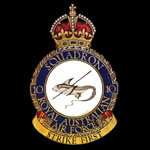RAAF No 10 Squadron
Motto: Strike First
No. 10 Squadron is a Royal Australian Air Force maritime patrol squadron based at RAAF Base Edinburgh. The squadron was first formed in 1939 and has seen active service in the Second World War, the East Timor intervention, the War on Terrorism and the 2003 Gulf War.
History
Second World War
No. 10 Squadron was formed on 1 July 1939 at RAAF Base Point Cook. Later that month aircrew and ground staff from the squadron departed for Britain to be trained on the Short Sunderland aircraft which had been acquired to equip the squadron. While it was intended that the aircrew would fly these aircraft to Australia after completing their training, following the outbreak of war the Australian government offered to retain the squadron in Britain. As a result, No. 10 Squadron was both the first RAAF squadron and the first British Commonwealth squadron to see active service in the Second World War, when one of its aircraft made a flight to Tunisia on 10 October 1939. It was also the only RAAF squadron to see continuous active service throughout the war.
Photo: No. 10 Squadron Sunderland sets out on patrol in 1941
The squadron's major tasks during the war were escorting convoys, conducting anti-submarine patrols, and air-sea rescue. It sank its first U-boat on 1 July 1940. Operating mainly from bases in southern Britain such as RAF Mount Batten in Plymouth,[4] the unit flew missions as far afield as Oban in Scotland and Malta in the Mediterranean Sea.
No. 10 Squadron sank a total of six U-boats between February 1940 and May 1945. It also set a Coastal Command record in February 1944 for the most patrol hours flown in a single month: 1143. Unit losses during the war were 19 aircraft and 150 men. Following the end of hostilities in Europe No. 10 Squadron began preparations to deploy to the Pacific Theatre, however this was curtailed by the Japanese surrender and it remained in Britain, disbanding in October 1945.
Post-war
No. 10 Squadron was re-formed at Townsville in March 1949 to increase the RAAF's reconnaissance capability. Operating modified Lincoln heavy bombers the squadron conducted maritime and anti-submarine patrols over northern Australia and the South Pacific. The squadron continued in this role after re-equipping with Neptune aircraft in March 1962, and the longer range of the Neptune allowed the squadron to operate over South East Asia and the Central Pacific in an area that was equal to "one tenth of the world's surface".
Throughout 1978-79, No. 10 Squadron was re-equipped with P-3C Orion aircraft and relocated to RAAF Base Edinburgh in South Australia. With the similarly equipped No. 11 Squadron, No. 10 Squadron continues to operate in the maritime patrol, surveillance and anti-shipping roles.
Since the 1980s, No. 10 Squadron has contributed to the RAAF maritime patrol detachment based at Butterworth Air Base in Malaysia. More recently, it supported the Australian-led intervention into East Timor in 1999 and has contributed to the Australian maritime patrol detachment based in the Persian Gulf since 2001. In this role the Squadron has supported coalition operations in Afghanistan and Iraq
Aircraft operated
The squadron has operated the following aircraft:
Short Sunderland (1939-1945);
Short S.26 G-Boat (1941);
Avro Lincoln (1949-1962);
Lockheed P2V-7S Neptune (1962-1977); and Lockheed P-3C Orion (1977- ).
No. 10 Squadron was also equipped with small numbers of Supermarine Seagull, Supermarine Southampton, de Havilland DH60 Moth floatplane, Consolidated Catalina and Supermarine Walrus aircraft for training purposes prior to receiving its Sunderland aircraft.Bibliography
Barnes, C.H.; James, D.N. (1989). Short Aircraft Since 1900. London: Putnam. ISBN 0-85177-819-4.
Eather, Steve (1995). Flying Squadrons of the Australian Defence Force. Weston Creek, Australian Capital Territory: Aerospace Publications. ISBN 1-875671-15-3.
RAAF Historical Section (1995). Units of the Royal Australian Air Force: A Concise History. Volume 4: Maritime Units. Canberra: Australian Government Publishing Service. ISBN 0-644-42796-5.
Stephens, Alan (2006) [2001]. The Royal Australian Air Force: A History. London: Oxford University Press. ISBN 0-19-555541-4.Web References:
History of RAF Organisation: http://www.rafweb.org/
Australian War Memorial: http://www.awm.gov.au/units/unit_11065.asp
Wikipedia, the free encyclopedia: http://en.wikipedia.org/

 Editor for Asisbiz: Matthew Laird Acred
Editor for Asisbiz: Matthew Laird Acred
If you love our website please subscribe to our YouTube video channel
Please donate so we can make this site even better !!
